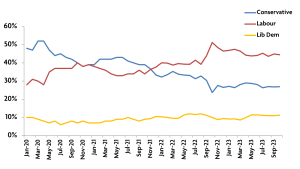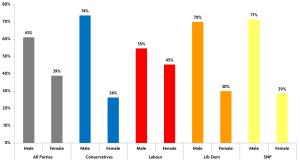By Nathan Coyne, Managing Director at PoliMapper
Change is coming to Westminster.
You could argue that, with a general election just around the corner, it is only to be expected.
But what’s of particular interest with this general election is the scale of potential change.
This is due to the combination of circumstances that sees large numbers of MPs standing down, and the potential for sequential landslide victories by different parties.
At the time of writing, data from Polimapper’s Candidate Connect database showed that 77 MPs had announced their intention to stand down permanently at the next election.
A further 28 had been either displaced by the Boundary Commission’s redrawing of parliamentary constituencies, been de-selected by their local party or lost the national party whip at Westminster.
With 105 of 650 MPs already accounted for, we next need to look at what the polls are telling us.
If reflected at the next general election, averages from 14 national polls in October 2023 show that Labour would secure a 15% swing from the Conservatives and a 13% swing from the SNP. The Liberal Democrats would secure a 10% swing from the Conservatives.
Should this transpire, the Conservatives’ landslide victory at the 2019 general election in England and the SNP’s in Scotland, would be entirely replaced by a Labour landslide victory in 2024.
This could lead to as many as 48% of MPs sitting in the House of Commons after the general election being new to the role.
To put this in context, only twice in the last 50 years has the number of new MPs exceeded one third – the landslide victory achieved by Tony Blair in 1997 (37%) and the advent of the coalition government in 2010 (33%).
Only once has the number of new MPs exceeded 50%; in 1945 when 324 of the then 640 MPs entered the House for the first time.
So what does this seismic level of change mean for associations and the organisations they represent?
To start with, you will need to prepare to invest in establishing relationships with the new cohort of MPs. Many of the networks you’ve carefully honed over several years will be holed below the water line and need to be replaced or renewed.
Such a large number of new MPs presents a policy challenge. What are their views? How many are broadly supportive of your interests? You’ll need to establish in which areas of policy such a large shake-up in personnel presents a threat, and in which it presents an opportunity.
But the good news is that you don’t need to wait until after the election to start this process – when incidentally you’d be competing with a whole host of other interests.
This is because a significant number of prospective parliamentary candidates have already been selected.
Polimapper’s Candidate Connect database shows that 275 prime candidates – defined as those succeeding an existing MP or standing in a key target seat – had already been selected (76% of the likely total).
Prime candidates are important because these are the candidates with the best chance of being elected and are thus worth an investment of time in getting to know.
There are many ways to do this, but we’ve picked out three that stand out.
Firstly, publish and send candidates your manifesto – ideally as succinctly packaged as possible in infographic or video form so they can digest your key messages.
Secondly, present them with information about your industry or profession through a constituency lens. Data on economic contribution, numbers of jobs, or simply just displaying information about member companies and facilities could help parliamentary candidates understand the value of your industry.
Thirdly, set up member site visits for parliamentary candidates. Allied with photo opportunities for the local press, site visits can be a win:win opportunity for associations and their members.
Unlike in 2017 and 2019, we have the benefit of time to prepare for a general election – it being anything from 5 to 11 months away.
With the level of change coming to Westminster, associations that use this time to invest in relationships with parliamentary candidates, are going to have a real advantage once the next parliament opens for business.
Nathan Coyne is the managing director of Polimapper.
Polimapper has published the first in-depth study into the characteristics of the 275-strong prime candidate pool, from which our new MPs will be drawn. Download the white paper at: http://www.polimapper.co.uk/class-of-24
Chart 1 – Voting intention since 2020

Chart 2 – gender split of prime candidates by party

